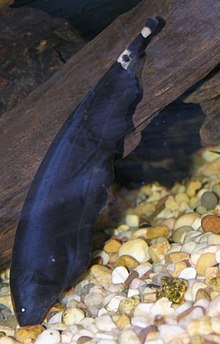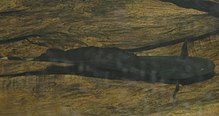| Black ghost knifefish | |
|---|---|

| |

| |
| Conservation status | |
 Least Concern (IUCN 3.1) | |
| Scientific classification | |
| Domain: | Eukaryota |
| Kingdom: | Animalia |
| Phylum: | Chordata |
| Class: | Actinopterygii |
| Order: | Gymnotiformes |
| Family: | Apteronotidae |
| Genus: | Apteronotus |
| Species: | A. albifrons |
| Binomial name | |
| Apteronotus albifrons (Linnaeus, 1766) | |
The black ghost knifefish (Apteronotus albifrons) is a tropical fish belonging to the ghost knifefish family (Apteronotidae). They originate in freshwater habitats in South America where they range from Venezuela to the Paraguay–Paraná River, including the Amazon Basin. They are popular in aquaria. The fish is all black except for two white rings on its tail, and a white blaze on its nose, which can occasionally extend into a stripe down its back. It moves mainly by undulating a long fin on its underside. It will grow to a length of 45–50 centimetres (18–20 in).
Black ghost knifefish are nocturnal. They are a weakly electric fish which use an electric organ and receptors distributed over the length of their body in order to locate prey, including insect larvae.

Natural habitat
The black ghost knifefish natively lives in sandy bottom creeks in South America. Natives believe that the ghosts of the departed take up residence in these fish, hence the name.
In aquaria
Black ghost knifefish require a medium sized tank of 110–150 litres (30–40 US gal) when smaller, though as they grow larger will require a much larger tank of around 300–340 litres (80–90 US gal). A lid is needed as they have been known to jump out. Black Ghost knifefish get to a maximum size of 50 cm (20 in) in the wild, but usually stop growing at 30 cm (12 in) in home aquaria, although they may grow to 38 cm (15 in) in a larger tank. They should be provided with a shelter (such as a plastic tube or driftwood) in which to hide. They prefer a dimly lit tank as their eyesight is optimized for low light. Black ghost knife fish are weakly electric fish. They will eat smaller fish in the tank and are intolerant of conspecifics. As with other scaleless fish, they are vulnerable to parasite infestations such as ich (Ichthyophthirius multifiliis). They can reproduce in captivity, although there are only a few reports of Black Ghost Knifefish reproducing. It is possible to use a device to convert a captive fish's electrical signals into audible sound, allowing listeners to hear the fish "talk". The Bakken Museum in Minneapolis has a display with such a device and a black ghost knifefish.
Electricity
The black ghost knifefish is a weakly electric fish as a result of the electromotor and electrosensory systems it possesses. While some fish can only receive electric signals, the black ghost knifefish can both produce and sense the electrical impulses. Electrogenesis occurs when a specialized electric organ found in the tail of the fish generates electrical signals, which are thus called electric organ discharges (EODs). Then, for these EODs to be sensed by the fish, electroreception occurs when groups of sensory cells embedded in the skin, known as electroreceptor organs, detect the electrical change. The EODs are used for two major purposes: electrolocation and communication.
The kind of EOD produced can be used to distinguish between two types of weakly electric fish: the pulse-type and the wave-type. The black ghost knifefish are considered to be the latter type, because they can continuously generate EODs in small intervals. Wave-type EODs have a narrow power spectra, and can be heard as a tonal sound, where the discharge rate establishes the fundamental frequency. By emitting its own continuous sinusoidal train of EODs, the fish can determine the presence of nearby objects by sensing perturbations in timing and amplitude of electric fields, an ability known as active electrolocation. The particular organs used to sense the self-generated high-frequency EODs are tuberous electroreceptor organs. On the other hand, when low-frequency electric fields are generated by external sources instead of the fish itself, a different class of electroreceptor organs is used for this passive electrolocation, called ampullary organs. Therefore, the black ghost knifefish uses an active and a passive electrosystem, each with its own corresponding receptor organs. The fish can also use a mechanosensory lateral line system, which detects water disturbances created by the motion of the fish's body. As nocturnal hunters, the fish can rely on all three systems to navigate through dark environments and detect their prey.
Each species has a characteristic EOD baseline frequency range, which varies with sex and age within the species, as well. The baseline frequency is maintained to be almost constant at stable temperature, but will usually be changed due to the presence of others of the same species. Such changes in frequency relevant to social interaction are called frequency modulations (FMs). The role these FMs have in communication is significant, as black ghost knifefish have developed jamming avoidance responses, which are behavioral responses that avoid the overlapping of EOD frequencies between conspecific individuals to prevent sensory confusion. Moreover, a study was conducted that focused on sexual dimorphism in electrocommunication signals. Female black ghost knifefish generate EODs at a higher frequency than the males, an FM which can be used for gender recognition. A study found the subordinate black ghost knifefish exhibited noticeable gradual frequency rises (GFRs) in their EODs whereas the dominant fish did not, supporting the researchers' hypothesis that GFRs during communication are indicative of submissive signals.
References
- Frederico, R.G. (2022). "Apteronotus albifrons". IUCN Red List of Threatened Species. 2022: e.T49829499A159047904. doi:10.2305/IUCN.UK.2022-2.RLTS.T49829499A159047904.en.
- Froese, Rainer; Pauly, Daniel (eds.). "Apteronotus albifrons". FishBase. May 2005 version.
- ^ Nelson M. E. & MacIver M. A. (1999). "Prey capture in the weakly electric fish Apteronotus albifrons: sensory acquisition strategies and electrosensory consequences". J. Exp. Biol. 202: 1195–1203, pdf
- Axelrod H. R. (1996). Exotic Tropical Fishes. T.F.H. Publications. ISBN 0-87666-543-1
- The Aqua Hobby website, http://www.aquahobby.com/gallery/e_Black_Ghost_Knife_Fish_Apteronotus_albifrons.php
- "Bakken Museum".
- Rose, Gary J. (December 2004). "Insights Into Neural Mechanisms and Evolution of Behaviour from Electric Fish". Nature Reviews Neuroscience. 5 (12): 943–951. doi:10.1038/nrn1558. PMID 15550949. S2CID 5874461.
- ^ Dunlap, K. D.; Thomas, P.; Zakon, H. H. (February 1998). "Diversity of sexual dimorphism in electrocommunication signals and its androgen regulation in a genus of electric fish, Apternotus". J Comp Physiol A. 183 (1): 77–89. doi:10.1007/s003590050236. PMID 9691480. S2CID 22926024.
- ^ Stoddard, Philip K. "Electric Signals & Electric Fish" (PDF): 1–14. Archived from the original (PDF) on 2010-10-31. Retrieved 2013-09-18.
{{cite journal}}: Cite journal requires|journal=(help) - ^ Stoddard, Philip K. (2002). Electric Signals: Predation, Sex, and Environmental Constraints (PDF). Advances in the Study of Behavior. Vol. 31. pp. 201–242. doi:10.1016/s0065-3454(02)80009-2. ISBN 9780120045310. Archived from the original (PDF) on 2006-09-17.
- Serrano-Fernandez, P. (Sep 2003). "Gradual frequency rises in interacting black ghost knifefish, Apteronotus albifrons". J Comp Physiol A. 189 (9): 685–692. doi:10.1007/s00359-003-0445-8. PMID 12898168. S2CID 8140293.
- Montgomery, John; Coombs, Sheryl; Halstead, Matthew (1995). "Biology of the mechanosensory lateral line in fishes". Reviews in Fish Biology and Fisheries. 5 (4): 399–416. Bibcode:1995RFBF....5..399M. doi:10.1007/bf01103813. S2CID 34065453.
.
Further reading
- MacIver M. A., Patankar N. A. & Shirgaonkar A. A. (2010). "Energy-Information Trade-Offs between Movement and Sensing". PLoS Computational Biology 6(5): e1000769. doi:10.1371/journal.pcbi.1000769
External links
- The MacIver Lab Homepage
- Black Ghost Knife Fish, Apteronotus albifrons (Linnaeus, 1766).BdFISH
- "Apteronotus albifrons". Integrated Taxonomic Information System. Retrieved 29 June 2005.
| Taxon identifiers | |
|---|---|
| Apteronotus albifrons | |
- IUCN Red List least concern species
- Apteronotidae
- Weakly electric fish
- Fish of the Amazon basin
- Freshwater fish of Argentina
- Fish of Bolivia
- Knifefish of Brazil
- Freshwater fish of Colombia
- Freshwater fish of Ecuador
- Fish of French Guiana
- Fish of Guyana
- Fish of Paraguay
- Freshwater fish of Peru
- Fish of Suriname
- Fish of Uruguay
- Freshwater fish of Venezuela
- Fish described in 1766
- Taxa named by Carl Linnaeus